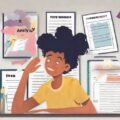Cognitive Behavioral Therapy (CBT) is a form of psychological treatment that has been demonstrated to be effective for a range of problems including depression, anxiety disorders, alcohol and drug use problems, marital problems, eating disorders and severe mental illness. Numerous research studies suggest that CBT leads to significant improvement in functioning and quality of life. In this article, we will explore seven of the best positive CBT techniques and worksheets that can help individuals improve their mental health and well-being.
Understanding CBT and Its Effectiveness
Cognitive Behavioral Therapy is a type of psychotherapeutic treatment that helps patients understand the thoughts and feelings that influence behaviors. CBT is commonly used to treat a wide range of disorders and is based on the combination of the basic principles from behavioral and cognitive psychology.
1. The Thought Record
The thought record is a fundamental tool in CBT. This technique encourages individuals to record their negative thoughts, the situation that led to it, the emotions associated with it, and the resulting behavior. By writing down these thoughts, it becomes easier to challenge and change them.
2. Cognitive Restructuring
Cognitive restructuring involves identifying and challenging irrational or maladaptive thoughts. Through this process, individuals learn to replace negative thoughts with more realistic and positive ones, which lead to more effective behavior.
3. Behavioral Activation
Behavioral activation is designed to increase your engagement in positive activities which you enjoy or find meaningful. It is based on the theory that doing positive activities can lead to a change in thoughts and feelings.
4. Exposure Therapy
Exposure therapy is a process for reducing fear and anxiety responses. It involves the exposure to the feared object or context without any danger in order to overcome their anxiety. It’s particularly effective for phobias and obsessive-compulsive disorders.
5. Problem-Solving
Problem-solving therapy is used to teach individuals a step-by-step process to solve problems. This technique is effective for those dealing with stress-inducing situations and helps to build resilience.
6. Relaxation Techniques
Relaxation techniques such as deep breathing, meditation, and progressive muscle relaxation can help reduce symptoms of stress and anxiety. These techniques can be used in conjunction with other CBT methods to manage physiological responses to stress.
7. Gratitude Journaling
Gratitude journaling is a positive psychology intervention that involves writing down things for which one is grateful. This simple practice has been shown to increase well-being and reduce symptoms of depression over time.
FAQ
What is CBT?
Cognitive Behavioral Therapy is a form of psychotherapy that focuses on modifying dysfunctional emotions, behaviors, and thoughts by interrogating and uprooting negative or irrational beliefs. It is a hands-on, practical approach to problem-solving.
Is CBT suitable for everyone?
CBT can be used for a wide range of ages and is suitable for children, adolescents, and adults. It has been extensively researched with strong evidence supporting its effectiveness for a variety of conditions.
How long does CBT treatment usually last?
CBT treatment can vary in length, but it is typically considered a short-term treatment, ranging from a few weeks to several months of sessions.
Can CBT be done on one’s own, or is a therapist always needed?
While CBT can be more effective under the guidance of a therapist, there are many resources available for those who wish to try some techniques on their own.
Are there any online CBT resources or worksheets available?
Yes, there are many online resources and worksheets available to help individuals practice CBT techniques. Some of these are free, while others may be part of a structured therapy program.









